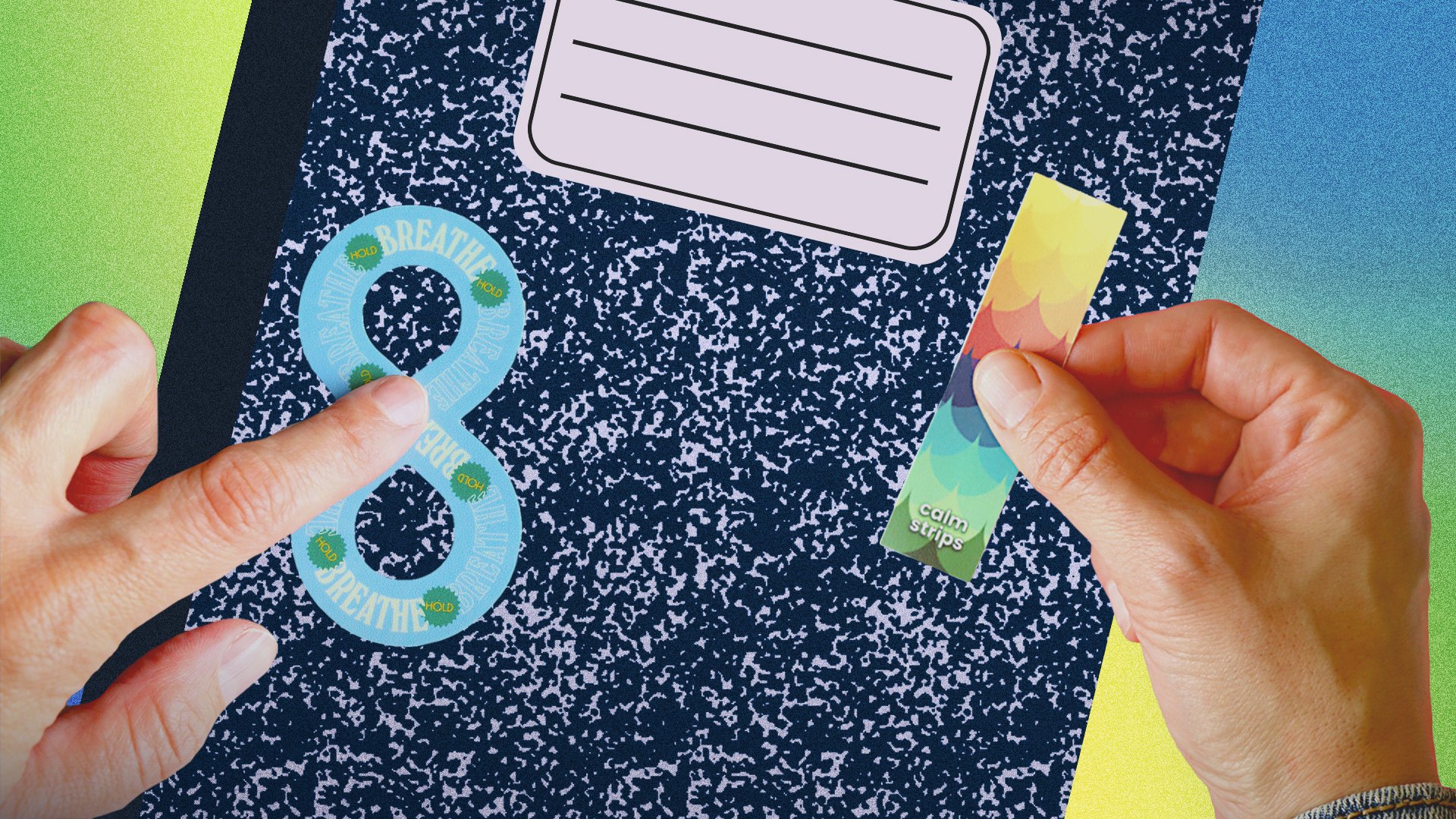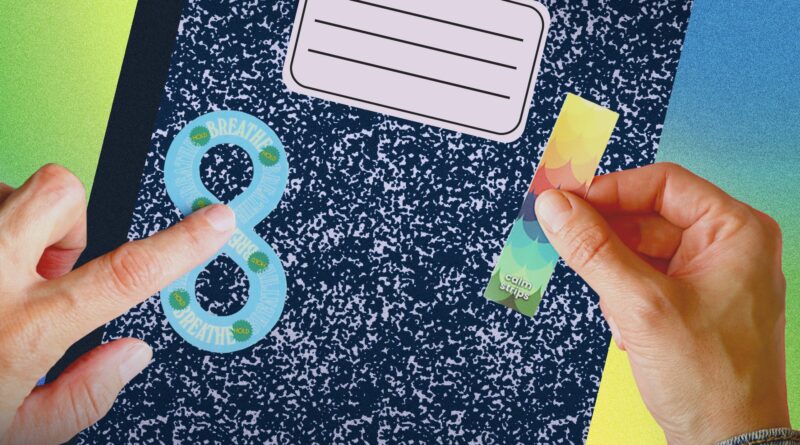This tactile sticker could help your mental health

For all the digital tools and AI-guided apps that can help us navigate our mental health and wellbeing, you can’t get there without spending time away from screens. Or, in the more succinct language of online arguments: go touch grass.
But maybe touching a sticker somewhere close to your screens can help ground you too.
That’s the claim of Calm Strips, reusable “sensory stickers” you may have seen popping up in ads or suggested posts on TikTok and Instagram. These colorful tactile stickers aren’t just cashing in on trendy Danish pastel aesthetics, they’re tapping into broad demand for neurodivergent support tools.
The original line of rectangular stickers, about the size of a finger, feature bright designs like rainbows, flowers, and landscapes. Newer variants add text: instructions to “ground yourself” or to remember that “you are not your intrusive thoughts.”
And then there’s the all-important tactility — the brand’s big selling point. Calm Strips feature various levels of textured surface, from bumpy “river rock” to “smooth satin.” They’re designed as an antidote to anxiety, sensory overstimulation, or other emotional states that can use a physical intervention.
Ironically, Calm Strips co-founders Michael Malkin and Luce Fuller got the idea for this analog product while working in the temple of high-tech screens, the arbiter of some of society’s biggest screen-focused troubles: An Apple store.
Malkin needed a subtle fidget, but couldn’t whip out a spinner, tangle toy, or Pop-It (some of the internet’s most popular fidget tools) in front of customers. So he calmed his anxiety by wrapping a piece of tape around his fingers.
It’s more of a tool than a toy.
A self-proclaimed “40-year-old anxious guy,” Malkin solicited more low-tech fidget concepts. At first, he thought the strips would be mainly for adults like him, but post-launch feedback — especially from the Autism community, which his son was diagnosed with — opened the opportunity to expand to an all-ages audience.
“A lot of brands that were talking about mental health, were talking at people, telling them what they needed, rather than listening to them,” Fuller told Mashable. “So that was one big, directional marker that we put in place and have continued to follow.”
The result was a spot on ABC’s business incubator show Shark Tank, where the pair nabbed a partnership with Canadian businessman Robert Herjavec. The Calm Strips mission, to get more people to embrace sensory tools, was on.
Stickers and somatics
Calm Strips, and other tactile fidgets, embody a self-care practice and field of study known as somatics. A term coined in 1976 by professor Thomas Hanna, somatics focuses on movement, bodywork, and regulating your nervous system. A lot of its basic concepts — body scans, conscious breathing, tactile activations — are also found in mindfulness practice.
“Sensory regulation is about stabilizing the nervous system, getting familiar with your own nervous system,” says Thérèse Cator, a trauma resolution practitioner and the founder of Embodied Black Girl. Shifting emotional states through sensory regulation is, for many, the first step toward a greater personal transformation through trauma healing or other therapies.
“In trauma resolution, you always do stabilization first,” Cator explained to Mashable. “If the person is feeling anxious, you’re trying to move them to calm.”
Fuller claims Calm Strips immediately resonated with people experiencing body-focused repetitive behaviors (BFRB), or self grooming compulsions like nail biting, skin and cuticle picking, or hair pulling. Customers with these needs reached out with positive stories and even product and texture requests. “To have somewhere to redirect that energy is really powerful,” Fuller says.
The products also appeal to people with Autism Spectrum Disorder. Fuller, a mom of five, knows this firsthand as a mother of a child with Autism. “The Autistic community is not only one of the coolest communities ever, but they’re also always searching for a good tool, as opposed to maybe a toy, that can be used anywhere,” Fuller says. Calm strips, she argues, are “more of a tool than a toy.”
You can find plenty of Calm Strips tips and opinions on Reddit forums such as r/AutismInWomen. Some users like them for stimming (self-stimulating behaviors often associated with Autism), or curbing BFRB. Others had the stickers recommended as coping devices by their therapists. Some teachers give them to students. A post on r/Kindle shows someone putting Calm Strips stickers on their device to fidget with as they read.
But some of the online conversation wonders whether the stickers are a scam. A subset of Shark Tank fans were shocked that the investors didn’t call out Fuller and Malkin for supposedly “deceiving” their customers, the panel’s custom for many more novelty items that grace the screen.
Such opinions are shared openly online, like among users on r/FidgetToys. “Only in America can you sell textured stickers for a profit,” laughed one user. “I much prefer worry stones, or any other handheld fidget,” said another. “That said, their infinity ones are better because tracing a figure eight is somehow more relaxing. I am a teacher and I put those under kids’ desks to calm them.”
Fuller and Malkin understand the urge to scoff at the simple stickers, part of a larger stigma against mental health tools.
“It is only four textures,” Fuller says. “But if you have Calm Strips right on the back of your phone, on your keys, it’s something you will always have with you. Nothing against your Fitbit, phone, Apple Watch, whatever, but [a Calm Strip] is not gonna nudge you while you’re in the middle of something. It’s at your own discretion, your own time.”
Inside the box
Far from being content with the original stickers, the Calm Strips brand is still expanding. Hence the Calm Breathing line: palm-sized stickers that guide you through basic breathwork techniques.
One turns box breathing, a four-part technique, into a literal box shape. Spending an equal amount of time on each of the four sides, you inhale deeply on one, hold on the second, exhale on the third, hold again on the fourth.
Another sticker in the shape of an infinity symbol introduces users to loop or “Lazy 8” breathing, a common practice used to treat childhood anxiety. A pie chart shaped-sticker represents the 54321 method, a grounding technique where you note five things you can see, four you can touch, three you can hear, two you can smell, and one you can taste.
Fuller says the breathing stickers boosted Calm Strips sales, and remain extremely popular, most likely because they are both aesthetically appealing and straightforward. “People liked that call to action,” Fuller says. “Every pack that comes in an order will have an instruction card. It’s got a little bit of information, a quote, and how to use it.”
Nothing against your phone, but a Calm Strip is not gonna nudge you while you’re in the middle of something.
Emotional regulation at your desk
While beneficial for all ages, mass market fidget toys are mostly geared toward younger users. That may explain why teachers appear as one of the largest purchasers of the less distracting Calm Strips. The brand even offers classroom packs and bulk ordering for educational institutions, with more than 5,000 schools nationwide using them desk-side.
“It is something that helps to teach not only mindfulness, but emotional intelligence and emotional regulation,” says Fuller. “To give these kids the ability to have something in front of them that can teach them emotional regulation at such a young age… I don’t know about you, but they didn’t teach that in my school.”
Before starting her career in trauma healing and coaching, Cator was a substitute and public school teacher. She’s a mother, too, and sees why kids might gravitate toward an eye-catching item like Calm Strips. “Any tool that’s helpful for children — that’s helpful for families —I am always going to be a supporter of,” she says. Many of us also need these tools, even the neurotypical, “because we have been in turbulent times for many, many years,” she explains.
“We’ve made Calm Strips beautiful as well as sensory,” Fuller says. In the call with Mashable, she proudly showed off her own sticker-plastered desk to prove the point. And this is exactly how she wants them to be used: a self-regulation tool designed to be open and public, rather than stowed away. That’s because manu people seeking sensory regulation tools are made to feel ashamed about needing self-soothing tools, she says.
“We don’t hide anything. We want the fact that it’s a tool to be used out in the open. It’s cool that it’s out there. They are cool designs. But they’re also discreet enough that if you don’t want to tell anybody, then you just got a cool sticker.”
Taping over our shame
“Shame is also something that happens within the body,” says Cator. But while being open about coping tools like Calm Strips might be a good first step to acceptance, it “doesn’t necessarily reconcile the shame, or deeper impacts of shame, that may be underneath.”
That’s where community collaborations with up and coming brands and trending items can fill a gap. “I definitely don’t believe in gatekeeping,” Cator says of mismatched resources and knowledge within the mental health space. She sees the demand for useful tools like these as a stop-gap for a greater societal need, but wants to make sure people know there’s still more work to do.
“We’re talking about stickers,” Cator says. “Someone may reach for it, and it might work one day, and then it might not work another day, or there might be one sticker that’s particularly activating for one person. It’s important to give context.”
Cator believes brands like Calm Strips should build out referral networks, connecting mental health organizations and community groups in this field, so they feel less pressure to be a one-size-fits-all solution. And a little support goes a long way.
Calm Strips is doing some of tthis work already. It’s collaborated with groups like LGBTQ+ therapist group QueerWell, childhood mindfulness organization BeWell in School, Black woman-led Sistas with ADHD, and, most recently, a line of emotional intelligence-building childrens’ books (now paired with their own line of Calm Strips) called FeelLinks.
The company has also teamed up with more unconventional partners, like the Broadway show How to Dance in Ohio, which stars a cast of autistic actors.
“We are so much more than just an item,” Fuller says. “I think a lot of what we do comes from the heart, and we really just want to help people.”

